 As part of the Basel III round of banking regulations, representatives of the EU Parliament and member governments have agreed with the European Commission that bankers’ bonuses should be capped. The proposal is to cap them at 100% of annual salary, or 200% with the agreement of shareholders. The full Parliament will vote in May and then it will go to officials from the 27 Member States. Under a system of qualified majority voting, it is expected to be accepted, despite UK resistance.
As part of the Basel III round of banking regulations, representatives of the EU Parliament and member governments have agreed with the European Commission that bankers’ bonuses should be capped. The proposal is to cap them at 100% of annual salary, or 200% with the agreement of shareholders. The full Parliament will vote in May and then it will go to officials from the 27 Member States. Under a system of qualified majority voting, it is expected to be accepted, despite UK resistance.
The main arguments in favour of a cap are that it will reduce the focus of bankers on short-term gains and reduce the incentive to take excessive risks. It will also appease the anger of electorates throughout the EU over bankers getting huge bonuses, especially in the light of the recession, caused in major part by the excesses of bankers.
 The main argument against is that it will drive talented top bankers to countries outside the EU. This is a particular worry of the UK government, fearful of the effect on the City of London. There is also the criticism that it will simply drive banks into increasing basic salaries of senior executives to compensate for lower bonuses.
The main argument against is that it will drive talented top bankers to countries outside the EU. This is a particular worry of the UK government, fearful of the effect on the City of London. There is also the criticism that it will simply drive banks into increasing basic salaries of senior executives to compensate for lower bonuses.
But it is not just the EU considering curbing bankers’ pay. The Swiss have just voted in a referendum to give shareholders the right to veto salaries and bonuses of executives of major companies. Many of these companies are banks or other financial sector organisations.
So just what will be the effect on incentives, banks’ performance and the movement of top bankers to countries without such caps? The following videos and articles explore these issues. As you will see, the topic is highly controversial and politically charged.
 Meanwhile, HSBC has revealed its 2012 results. It paid out $1.9bn in fines for money laundering and set aside a further $2.3bn for mis-selling financial products in the UK. But its underlying profits were up 18%. Bonuses were up too. The 16 top executives received an average of $4.9m each. The Chief Executive, Stuart Gulliver, received $14.1m in 2012, 33% up on 2011 (see final article below).
Meanwhile, HSBC has revealed its 2012 results. It paid out $1.9bn in fines for money laundering and set aside a further $2.3bn for mis-selling financial products in the UK. But its underlying profits were up 18%. Bonuses were up too. The 16 top executives received an average of $4.9m each. The Chief Executive, Stuart Gulliver, received $14.1m in 2012, 33% up on 2011 (see final article below).
Webcasts and podcasts
 EU moves to cap bankers bonuses Euronews on Yahoo News (1/3/13)
EU moves to cap bankers bonuses Euronews on Yahoo News (1/3/13)
 EU to Curb Bank Bonuses WSJ Live (28/2/13)
EU to Curb Bank Bonuses WSJ Live (28/2/13)
 Inside Story – Curbing Europe’s bank bonuses AlJazeera on YouTube (1/3/13)
Inside Story – Curbing Europe’s bank bonuses AlJazeera on YouTube (1/3/13)
 Will EU bonus cap ‘damage economy’? BBC Radio 4 Today Programme (28/2/13)
Will EU bonus cap ‘damage economy’? BBC Radio 4 Today Programme (28/2/13)
 Swiss back curbs on executive pay in referendum BBC News (3/3/13)
Swiss back curbs on executive pay in referendum BBC News (3/3/13)
 Has the HSBC scandal impacted on business? BBC News, Jeremy Howell (4/3/13)
Has the HSBC scandal impacted on business? BBC News, Jeremy Howell (4/3/13)
Articles
Bonuses: the essential guide The Guardian, Simon Bowers, Jill Treanor, Fiona Walsh, Julia Finch, Patrick Collinson and Ian Traynor (28/2/13)
Q&A: EU banker bonus cap plan BBC News (28/2/13)
Outcry, and a Little Cunning, From Euro Bankers The New York Times, Landon Thomas Jr. (28/2/13)
Bank bonuses may shrink – but watch as the salaries rise The Observer, Rob Taylor (3/3/13)
Don’t cap bank bonuses, scrap them The Guardian, Deborah Hargreaves (28/2/13)
Capping banker bonuses simply avoids facing real bank problems The Telegraph, Mats Persson (2/3/13)
Pro bonus The Economist, Schumpeter column (28/2/13)
‘The most deluded measure to come from Europe since fixing the price of groceries in the Roman Empire’: Boris Johnson attacks EU banker bonus cap Independent, Gavin Cordon , Geoff Meade (28/2/13)
EU agrees to cap bankers’ bonuses BBC News (28/2/13)
Viewpoints: EU banker bonus cap BBC News (28/2/13)
Voters crack down on corporate pay packages swissinfo.ch , Urs Geiser (3/3/13)
Swiss voters seen backing executive pay curbs Reuters, Emma Thomasson (3/3/13)
Swiss referendum backs executive pay curbs BBC News (3/3/13)
Voters in Swiss referendum back curbs on executives’ pay and bonuses The Guardian, Kim Willsher and Phillip Inman (3/3/13)
Swiss vote for corporate pay curbs Financial Times, James Shotter and Alex Barker (3/3/13)
HSBC pays $4.2bn for fines and mis-selling in 2012 BBC News (4/3/13)
Questions
- How does competition, or a lack of it, in the banking industry affect senior bankers’ remuneration?
- What incentives are created by the bonus structure as it is now? Do these incentives result in desirable outcomes?
- How would you redesign the bonus system so that the incentives resulted in beneficial outcomes?
- If bonuses are capped as proposed by the EU, how would you assess the balance of advantages and disadvantages? What additional information would you need to know to make such an assessment?
- How has the relationship between banks and central banks over the past few years created a moral hazard? How could such a moral hazard be eliminated?
 With many countries struggling to recover from the depression of the past few years, central banks are considering more and more doveish moves to kick-start lending. But with short-term interest rates in the USA, the UK and Japan close to zero, the scope for further cuts are limited. So what can central banks do?
With many countries struggling to recover from the depression of the past few years, central banks are considering more and more doveish moves to kick-start lending. But with short-term interest rates in the USA, the UK and Japan close to zero, the scope for further cuts are limited. So what can central banks do?
The first thing that can be done is to adopt a higher inflation target or to accept inflation above target – at least for the time being. This could be accompanied by explicitly targeting GDP growth (real or nominal) or unemployment (see the blog from last December, Rethinking central bank targets).
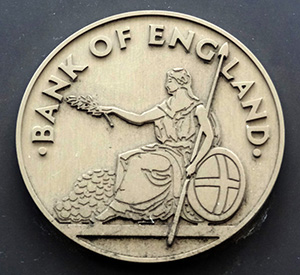 The second option is to increase quantitative easing. Although in a minority at the last MPC meeting, Mervyn King, the current Bank of England Governor, argued for a further £25 billion of asset purchases (bringing the total to £400bn) (see MPC minutes paragraph 39). It is highly likely that the MPC will agree to further QE at its next meeting in March. In Japan, the new governor of the Bank of Japan is expected to include asset purchases as part of the policy of monetary easing.
The second option is to increase quantitative easing. Although in a minority at the last MPC meeting, Mervyn King, the current Bank of England Governor, argued for a further £25 billion of asset purchases (bringing the total to £400bn) (see MPC minutes paragraph 39). It is highly likely that the MPC will agree to further QE at its next meeting in March. In Japan, the new governor of the Bank of Japan is expected to include asset purchases as part of the policy of monetary easing.
The third option is for the central bank to provide finance at below-market rates of interest directly to the banking sector specifically for lending: e.g. to small businesses or for house purchase. The Bank of England’s Funding for Lending Scheme is an example and the Bank is considering extending it to other financial institutions.
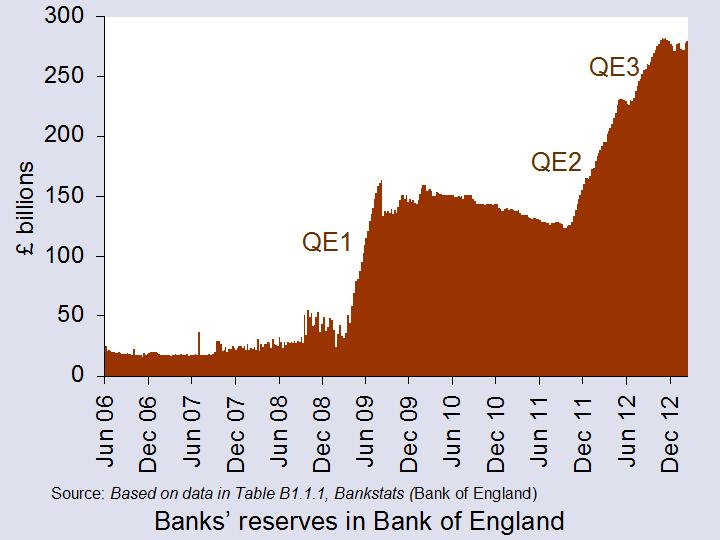 One other approach, mooted by the Bank of England’s Deputy Governor before the House of Commons Treasury Select Committee, is for negative interest rates paid on Banks’ reserves in the Bank of England. This would, in effect, be a fee levied on banks for keeping money on deposit. The idea would be to encourage banks to lend the money and not to keep excessive liquidity. As you can see from the chart, three rounds of quantitative easing have led to a huge increase in bank’s reserves at the Bank of England. (Click here for a PowerPoint of the chart.)
One other approach, mooted by the Bank of England’s Deputy Governor before the House of Commons Treasury Select Committee, is for negative interest rates paid on Banks’ reserves in the Bank of England. This would, in effect, be a fee levied on banks for keeping money on deposit. The idea would be to encourage banks to lend the money and not to keep excessive liquidity. As you can see from the chart, three rounds of quantitative easing have led to a huge increase in bank’s reserves at the Bank of England. (Click here for a PowerPoint of the chart.)
The following articles consider these various proposals and whether they will work to stimulate lending and thereby aggregate demand and economic recovery.
Central banks: Brave new words The Economist (23/2/13)
Phoney currency wars The Economist (16/2/13)
Analysis: Global central banks will keep taking it easy Reuters, Alan Wheatley (22/2/13)
Quantitative easing: the markets are struggling with a serious drug habi The Guardian, Larry Elliott (24/2/13)
Negative interest rates idea floated by Bank’s Paul Tucker BBC News (26/2/13)
Bank of England mulls negative interest rates Independent, Ben Chu (26/2/13)
BoE floats extending Funding for Lending to non-banks Mortgage Solutions, Adam Williams (26/2/13)
Funding for Lending Scheme failing to get banks lending Left Foot Forward, James Bloodworth (26/2/13)
Mortgage market boosted by lending schemes, says Redrow BBC News (26/2/13)
Widespread quantitative easing risks ‘QE wars’ and stagnation The Guardian, Nouriel Roubini (28/2/13)
Questions
- Consider each of the methods outlined above and their chances of success in stimulating aggregate demand.
- Go through each of the methods and consider the problems they are likely to create/have created.
- How important is it that monetary policy measures affect people’s expectations?
- What effects do the measures have on the distribution of income between borrowers and savers?
- What are annuities? How are these affected by policies of monetary easing?
- How has actual and anticipated Japanese monetary policy affected the exchange rate of the Japanese yen? How is this likely to affect the Japanese economy?
- Explain the sub-heading of the final article above, “When several major central banks pursue QE at the same time, it becomes a zero-sum game”. Do you agree?
 Eurozone leaders met at a summit in Brussels on 28 and 29 June. Expectations ahead of the summit were low that any significant progress would be made on supporting eurozone banks and governments, on achieving more effective bank regulation or stimulating economic growth.
Eurozone leaders met at a summit in Brussels on 28 and 29 June. Expectations ahead of the summit were low that any significant progress would be made on supporting eurozone banks and governments, on achieving more effective bank regulation or stimulating economic growth.
For once, EU leaders surprised markets by reaching a more comprehensive agreement than anticipated. The agreement has five key elements:
1. The use of funds from the soon-to-be launched eurozone bailout fund, the European Stability Mechanism (ESM), to lend to banks directly. Previously, funds had been made available to national governments to lend to their banks. This, however, increased the debts of the national governments, such as Spain, which made it harder for them to meet deficit and debt targets.
2. The setting up of a new banking supervisory body to impose common standards, such as capital adequacy requirements, on banks across the eurozone.
3. The use of the eurozone bailout fund to buy government bonds on the secondary market, provided governments are sticking to agreed deficit reduction measures. This would help to reduce interest rates on government bonds in countries such as Spain, Italy and Greece, currently having to pay interest rates 5 or 6 percentage points above those on German bonds.
4. A €120bn growth package to target EU money at small businesses, youth unemployment and infrastructure improvements. Most of the money would be from existing funds, such as EU Structural Funds, which are currently unused. There would be some additional funds, however, including €10bn to boost the lending capacity of the European Investment Bank.
5. A 10-year ‘roadmap’ towards greater fiscal union, including the creation of a eurozone treasury, which could limit overall spending by national governments.
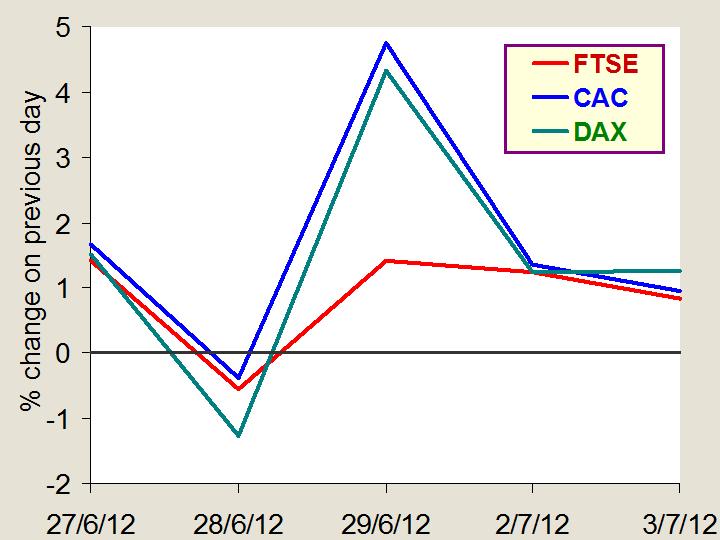 Generally the agreement has been greeted positively, with stock markets in the eurozone and across the world rising significantly. But will the measures be enough to reassure investors over the coming weeks? Will they cure the problems of the eurozone or are they just one more, albeit larger, sticking plaster?
Generally the agreement has been greeted positively, with stock markets in the eurozone and across the world rising significantly. But will the measures be enough to reassure investors over the coming weeks? Will they cure the problems of the eurozone or are they just one more, albeit larger, sticking plaster?
The following webcasts, podcasts and articles look at the agreement and the resulting prospects for the eurozone.
Webcasts and podcasts
 Eurozone bends the rules to save single currency euronews (29/6/12)
Eurozone bends the rules to save single currency euronews (29/6/12)
 Markets Like Euro Crisis Deal, Merkel Defensive Associated Press (29/6/12)
Markets Like Euro Crisis Deal, Merkel Defensive Associated Press (29/6/12)
 Eurozone crisis: ‘Breakthrough’ at summit BBC News, Gavin Hewitt (29/6/12)
Eurozone crisis: ‘Breakthrough’ at summit BBC News, Gavin Hewitt (29/6/12)
 EU summit outcome exceeds – low – expectations euronews (29/6/12)
EU summit outcome exceeds – low – expectations euronews (29/6/12)
 Italy and Spain are main beneficiaries after EU summit euronews (30/6/12)
Italy and Spain are main beneficiaries after EU summit euronews (30/6/12)
 EU bank aid deal ‘better than expected, worse than needed’ euronews (29/6/12)
EU bank aid deal ‘better than expected, worse than needed’ euronews (29/6/12)
 New eurozone deal ‘not enough’ BBC Today Programme, James Shugg (29/6/12)
New eurozone deal ‘not enough’ BBC Today Programme, James Shugg (29/6/12)
 Eurozone: ‘Massive concession’ from Angela Merkel BBC Today Programme, Gavin Hewitt and Robert Peston (29/6/12)
Eurozone: ‘Massive concession’ from Angela Merkel BBC Today Programme, Gavin Hewitt and Robert Peston (29/6/12)
Articles
Eurozone bank bailout deal throws lifeline to Spain and Italy Guardian, Ian Traynor and Phillip Inman (29/6/12)
Spain lifeline after EU allows direct access to eurozone bailout funds Guardian (29/6/12)
Less disunion The Economist, Charlemagne’s notebook (29/6/12)
Eurozone agrees on bank recapitalisation BBC News (29/6/12)
Merkel defends compromise deal on eurozone banks BBC News (29/6/12)
A first, tentative step to salvation for the eurozone Independent, Leading article (29/6/12)
Analysis – Sharing a vision may be Europe’s biggest challenge Reuters, Alan Wheatley (3/7/12)
Eurozone bank agreement welcomed FT Adviser, Rebecca Clancy & Bradley Gerrard (2/7/12)
The real victor in Brussels was Merkel Financial Times, Wolfgang Münchau (1/7/12)
Finns, Dutch cast first doubt on EU summit deal EurActiv (3/7/12)
A Euro deal from Brussels BBC News, Stephanie Flanders (29/6/12)
Document
Conclusions of the European Council (28/29 June 2012) European Council (29/6/12)
Questions
- What are the advantages of the ESF lending to banks directly? Are there any problems associated with the proposal?
- To what extent will the measures solve the problems of the eurozone? What else might need to be done?
- Are there any potential moral hazards contained in the proposals and how are they likely to be tackled?
- Explain the concept of ‘seniority’ in the following statement: “the debt owed by Spain to the EFSF, if and when it is transferred to the ESM, will not gain seniority”. Why might this be good for private financiers?
- If governments’ bonds are to be purchased by the ESM, what conditions are likely to be attached?
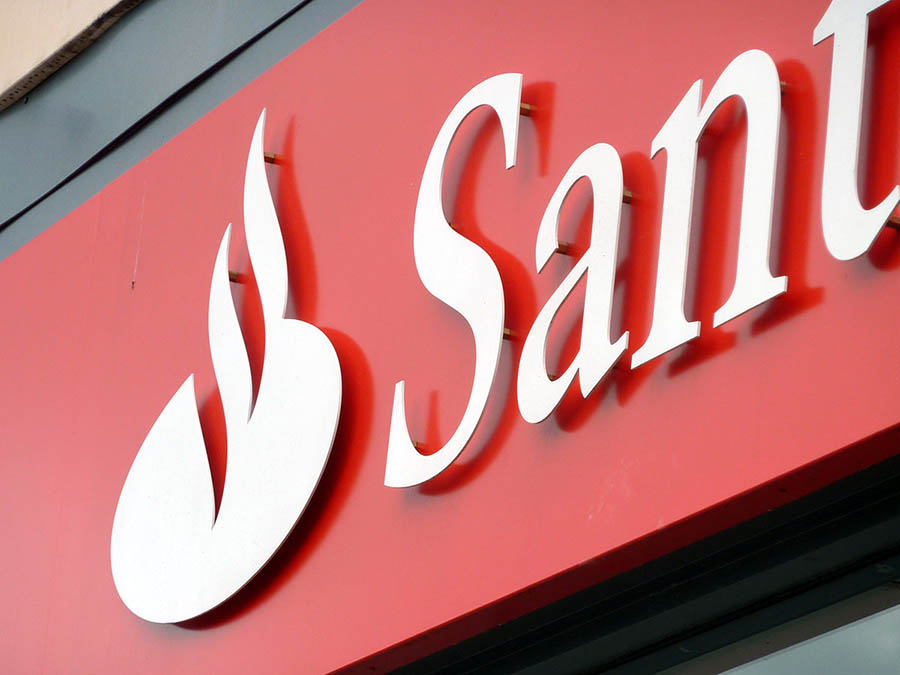 With falling GDP and house prices, Spanish banks have been running the risk of failure. Indeed, the Spanish government has already had to agree to bail out Spain’s fourth biggest bank, Bankia.
With falling GDP and house prices, Spanish banks have been running the risk of failure. Indeed, the Spanish government has already had to agree to bail out Spain’s fourth biggest bank, Bankia.
On Saturday 9 June, at a crisis conference call, eurozone finance ministers agreed to lend the Spanish government up to €100 billion to provide credit to Spanish banks. The Spanish government is commissioning independent audits of the banks and, in the light of that, will specify just how much it needs to borrow.
 Details of the nature of the loans will be made clear over the coming days, but they will funded either from the temporary rescue fund, the European Financial Stability Facility (EFSF), or from the new permanent fund that will replace it, the European Stability Mechanism (ESM).
Details of the nature of the loans will be made clear over the coming days, but they will funded either from the temporary rescue fund, the European Financial Stability Facility (EFSF), or from the new permanent fund that will replace it, the European Stability Mechanism (ESM).
But whilst the loans will remove the immediate pressure on Spanish banks, the underlying problems of the Spanish economy remain. Easy credit fuelled a property bubble which then burst. House prices have fallen by over 20% since the peak, and many Spanish people are in negative equity. Many construction companies have gone out of business.
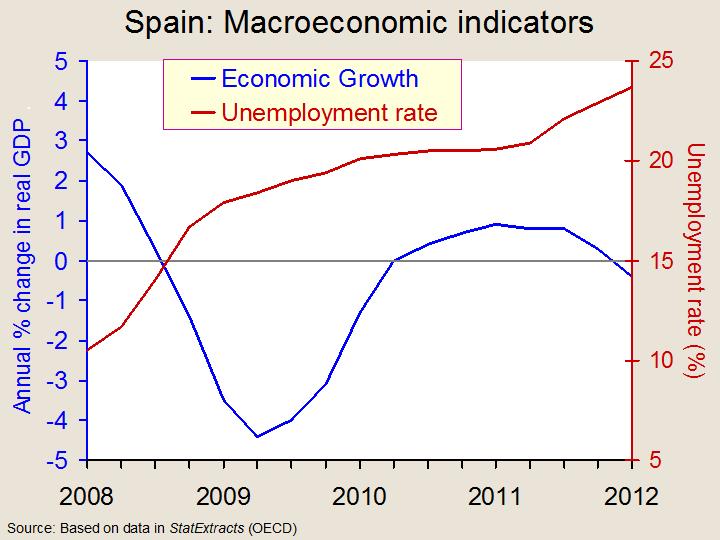 What is more, the Spanish government is committed to reducing the budget deficit from 8.9% of GDP in 2011 to 5.3% in 2012 and 3% in 2013. To achieve this it has instituted tough austerity policies of government expenditure cuts and tax rises. (Click here for a link to a graph from the BBC of budget deficits in 18 EU countries.)
What is more, the Spanish government is committed to reducing the budget deficit from 8.9% of GDP in 2011 to 5.3% in 2012 and 3% in 2013. To achieve this it has instituted tough austerity policies of government expenditure cuts and tax rises. (Click here for a link to a graph from the BBC of budget deficits in 18 EU countries.)
This has only aggravated the decline in GDP – at least in the short term. Spanish GDP is set to fall by around 2% this year and unemployment, at nearly 25% and rising, is the highest in Europe. Indeed the unemployment rate for those aged 15 to 25 is over 51%! This clearly has profound social and political consequences, with many young people seeing no prospect of gaining employment and thus feeling socially alienated. (For a PowerPoint of the above chart, click here.)
 Markets on the Monday after the bailout was announced initially reacted positively. By the end of the day, however, the gains had been wiped out. Although no conditions were imposed on the Spanish government – the loan, although to the Spanish government, was to bail out the banks, not the government itself – worries remain that the Spanish economy is not set to recover for some time.
Markets on the Monday after the bailout was announced initially reacted positively. By the end of the day, however, the gains had been wiped out. Although no conditions were imposed on the Spanish government – the loan, although to the Spanish government, was to bail out the banks, not the government itself – worries remain that the Spanish economy is not set to recover for some time.
What is more, worries about other eurozone countries in difficulty have not gone away. Indeed, with the Spanish government being seen as having been dealt with more leniently than the Greek, Portuguese and Irish governments, investors are now worried that these countries may demand to renegotiate the terms of their bailout. And in the case of Greece, the Spanish bailout may make people more willing to vote in this coming Saturday’s election for parties that reject the Greek bailout terms. This may make it more likely that Greece will be forced to leave the euro, with all the chaos that is likely to ensue.
Webcasts and Podcasts
 Spain: Simmering anger in Seville BBC News, Paul Mason (7/6/12)
Spain: Simmering anger in Seville BBC News, Paul Mason (7/6/12)
 Will Spain’s Bailout save Europe? CNBC Video, Martin Wolf (11/6/12)
Will Spain’s Bailout save Europe? CNBC Video, Martin Wolf (11/6/12)
 Bailout boost evaporates Financial Times video, James Macintosh (11/6/12)
Bailout boost evaporates Financial Times video, James Macintosh (11/6/12)
 Spain’s bailout may not be enough Financial Times video, Nikki Tait (11/6/12)
Spain’s bailout may not be enough Financial Times video, Nikki Tait (11/6/12)
 Eurozone: ‘Italy will be next’ BBC Today Programme, Robert Peston (11/6/12)
Eurozone: ‘Italy will be next’ BBC Today Programme, Robert Peston (11/6/12)
Articles
Eurozone agrees to lend Spain up to 100 billion euros MSN Money, Jan Strupczewski and Julien Toyer (12/6/12)
Hurried Spanish banking bailout fails to calm market nerves Guardian, Giles Tremlett (11/6/12)
Fears that Spain’s bailout relief may be short-live Independent, Alasdair Fotheringham and Tom Bawden (11/6/12)
Spanish banks deal: Market concerns remain BBC News (11/6/12)
Q&A: Spanish bank deal BBC News (11/6/12)
Debt crisis: Market euphoria evaporates over Spain’s €100bn bank bailout The Telegraph, Emma Rowley and Bruno Waterfield (11/6/12)
Why bondholders are scared about Spain MarketWatch, Deborah Levine (11/6/12)
Krugman on another bank bailout Press-Telegram Paul Krugman (11/6/12)
Messy Spanish rescue BBC News, Robert Peston (10/6/12)
This latest euro fix will come apart in less than a month The Telegraph, Jeremy Warner (11/6/12)
The consequences of Spain’s bank rescue Financial Times, Gavyn Davies (10/6/12)
Buy on the summit, sell on the communiqué Financial Times, Alan Beattie (11/6/12)
The vicious euro circle keeps turning BBC News, Stephanie Flanders (12/6/12)
Spanish banks need up to 62bn euros BBC News (21/6/12)
Eurozone crisis explained BBC News (19/6/12)
Spain formally requests a bailout for its banks BBC News (25/6/12)
Documents and press releases
IMF Says Spain’s Core Financial System is Resilient, but Important Vulnerabilities Remain IMF Press Release (8/6/12)
Spain and the IMF IMF links to various documents including: Spain – Financial System Stability Assessment (8/6/12)
Eurogroup statement on Spain Eurozone Portal, The Eurogroup (9/6/12)
Questions
- How does the Spanish bailout differ from those for Greece, Irelend and Portugal?
- What are the likely implications for Spanish borrowing costs of the loans coming from the ESM?
- To what extent does the plan to bail out Spanish banks involve a moral hazard?
- What is likely to be the effect of the Spanish bailout on Greece, Ireland and Portugal?
- How bad is Spanish public-sector debt compared with other countries? What is the likely effect of the bailout on Spanish public-sector debt?
- What is meant by a banking union in the eurozone and how would it work? What would be the implication of a eurozone banking union for the UK?
 On 2 May 2012, Sir Mervyn King, Governor of the Bank of England, gave the BBC Today Prgramme’s public lecture. In it, he reflected on the causes and aftermath of the banking crisis of 2007/8.
On 2 May 2012, Sir Mervyn King, Governor of the Bank of England, gave the BBC Today Prgramme’s public lecture. In it, he reflected on the causes and aftermath of the banking crisis of 2007/8.
He said that the main cause of the banking crisis was the risky behaviour of the banks themselves – behaviour that they had been allowed to get away with becuase regulation was too light. The cause was not one of inappropriate fiscal and monetary policy.
According to Dr King, there had been no classical macroeconomic boom and bust. True there had been a bust, but there was no preceding boom. Economic growth had not been unsustainable in the sense of being persistently above the potential rate. In other words, the output gap had been close to zero. As Mervyn King puts it
Let me start by pointing out what did not go wrong. In the five years before the onset of the crisis, across the industrialised world growth was steady and both unemployment and inflation were low and stable. Whether in this country, the United States or Europe, there was no unsustainable boom like that seen in the 1980s; this was a bust without a boom.
In terms of monetary policy, inflation had been on track and interest rates were not too low. And as for fiscal policy, government borrowing had been within the Golden Rule, whereby, over the cycle, the goverment borrowed only to invest and kept a current budget balance. Indeed, the period of the late 1990s and early to mid 2000s had become known as the Great Moderation.
So what went wrong? Again in the words of Dr King:
In a nutshell, our banking and financial system overextended itself. That left it fragile and vulnerable to a sudden loss of confidence.
The most obvious symptom was that banks were lending too much. Strikingly, most of that increase in lending wasn’t to families or businesses, but to other parts of the financial system. To finance this, banks were borrowing large amounts themselves. And this was their Achilles’ heel. By the end of 2006, some banks had borrowed as much as £50 for every pound provided by their own shareholders. So even a small piece of bad news about the value of its assets would wipe out much of a bank’s capital, and leave depositors scurrying for the door. What made the situation worse was that the fortunes of banks had become closely tied together through transactions in complex and obscure financial instruments. So it was difficult to know which banks were safe and which weren’t. The result was an increasingly fragile banking system.
But doesn’t his imply that regulation of the banking system had failed? And if so why? And have things now been fixed – so that banks will no longer run the risk of failure? Dr King addresses this issue and others in his speech and also in his interview the next day for the Today Programme, also linked to below.
Podcasts
The Today Programme Lecture BBC Radio 4, Sir Mervyn King (2/5/12) (Transcript of speech)
Also on YouTube at Governor’s Today Programme lecture, 2 May 2012
Sir Mervyn King: The full interview BBC Today Programme, Sir Mervyn King talks to Evan Davis (3/5/12)
Sir Mervyn King analysis ‘verging on delusional’ BBC Today Programme, Dylan Grice and Ngaire Woods (3/5/12)
Articles
Sir Mervyn King rejects criticism for crisis BBC News (3/5/12)
The boom and bust of Mervyn King BBC News, Robert Peston (3/5/12)
Sir Mervyn King admits BoE failed over financial crisis The Telegraph, Philip Aldrick (3/5/12)
Sir Mervyn King admits: we did too little to warn of economic crisis Guardian, Larry Elliott (2/5/12)
King Says BOE Will Risk Unpopularity to Prevent Crises Bloomberg, Jennifer Ryan and Scott Hamilton (3/5/12)
Data
Economic Outlook Annex Tables OECD (See Annex Tables 1, 10, 14, 18, 27, 28, 32, 33, 61 and 62)
Statistical Interactive Database Bank of England (See for example, A Money and Lending: counterparts to changes in M4, alternative presentation > Seasonally adjusted > Public sector contribution > PSNCR)
Questions
- Why was the period of the late 1990s and early to mid 2000s described as the Great Moderation?
- Chart the size of the output gap, the rate of inflation and public-sector deficits as a percentage of GDP in the UK and other major economies from 1995 to 2007. Is this evidence of the Great Moderation?
- To what extent would evidence of house prices, consumer debt, bank lending and the balance of trade deficit suggest that there was indeed a boom from the mid 1990s to 2007?
- What, according to Dr King were the main causes of the credit crunch?
- What, with hindsight, should the Bank of England have done differently?
- What UK body was responsible for regulating banks in the run up to the credit crunch? Why might its regulation be described as ‘light touch’?
- In what sense was there a moral hazard in central banks being willing to bail out banks?
- What banking reforms have taken place or will take place in the near future? Will they address the problems identified by Dr King and prevent another banking crisis ever occurring again?
 As part of the Basel III round of banking regulations, representatives of the EU Parliament and member governments have agreed with the European Commission that bankers’ bonuses should be capped. The proposal is to cap them at 100% of annual salary, or 200% with the agreement of shareholders. The full Parliament will vote in May and then it will go to officials from the 27 Member States. Under a system of qualified majority voting, it is expected to be accepted, despite UK resistance.
As part of the Basel III round of banking regulations, representatives of the EU Parliament and member governments have agreed with the European Commission that bankers’ bonuses should be capped. The proposal is to cap them at 100% of annual salary, or 200% with the agreement of shareholders. The full Parliament will vote in May and then it will go to officials from the 27 Member States. Under a system of qualified majority voting, it is expected to be accepted, despite UK resistance. The main argument against is that it will drive talented top bankers to countries outside the EU. This is a particular worry of the UK government, fearful of the effect on the City of London. There is also the criticism that it will simply drive banks into increasing basic salaries of senior executives to compensate for lower bonuses.
The main argument against is that it will drive talented top bankers to countries outside the EU. This is a particular worry of the UK government, fearful of the effect on the City of London. There is also the criticism that it will simply drive banks into increasing basic salaries of senior executives to compensate for lower bonuses. Meanwhile, HSBC has revealed its 2012 results. It paid out $1.9bn in fines for money laundering and set aside a further $2.3bn for mis-selling financial products in the UK. But its underlying profits were up 18%. Bonuses were up too. The 16 top executives received an average of $4.9m each. The Chief Executive, Stuart Gulliver, received $14.1m in 2012, 33% up on 2011 (see final article below).
Meanwhile, HSBC has revealed its 2012 results. It paid out $1.9bn in fines for money laundering and set aside a further $2.3bn for mis-selling financial products in the UK. But its underlying profits were up 18%. Bonuses were up too. The 16 top executives received an average of $4.9m each. The Chief Executive, Stuart Gulliver, received $14.1m in 2012, 33% up on 2011 (see final article below). EU moves to cap bankers bonuses Euronews on Yahoo News (1/3/13)
EU moves to cap bankers bonuses Euronews on Yahoo News (1/3/13) EU to Curb Bank Bonuses WSJ Live (28/2/13)
EU to Curb Bank Bonuses WSJ Live (28/2/13) Inside Story – Curbing Europe’s bank bonuses AlJazeera on YouTube (1/3/13)
Inside Story – Curbing Europe’s bank bonuses AlJazeera on YouTube (1/3/13) Will EU bonus cap ‘damage economy’? BBC Radio 4 Today Programme (28/2/13)
Will EU bonus cap ‘damage economy’? BBC Radio 4 Today Programme (28/2/13) Swiss back curbs on executive pay in referendum BBC News (3/3/13)
Swiss back curbs on executive pay in referendum BBC News (3/3/13) Has the HSBC scandal impacted on business? BBC News, Jeremy Howell (4/3/13)
Has the HSBC scandal impacted on business? BBC News, Jeremy Howell (4/3/13)








